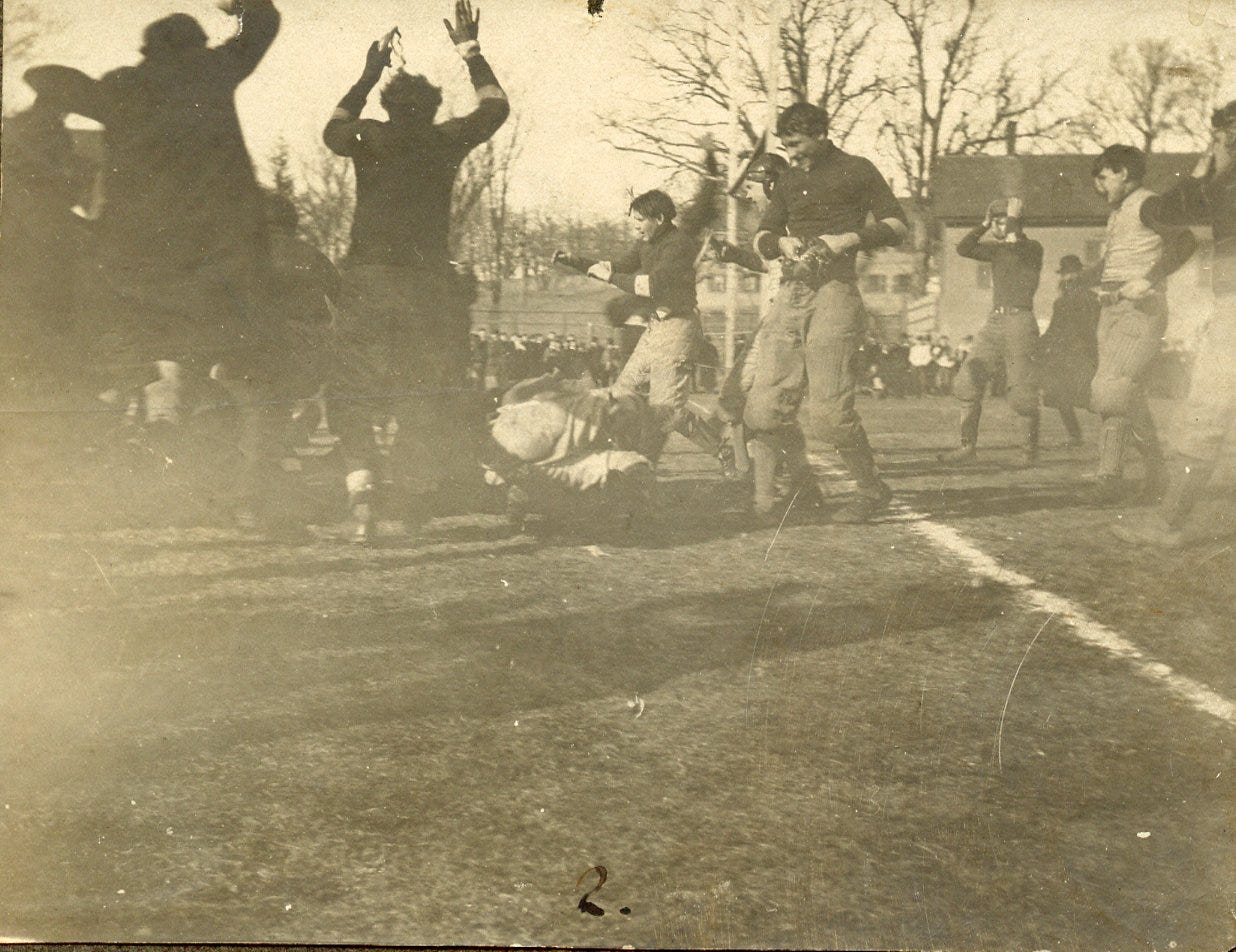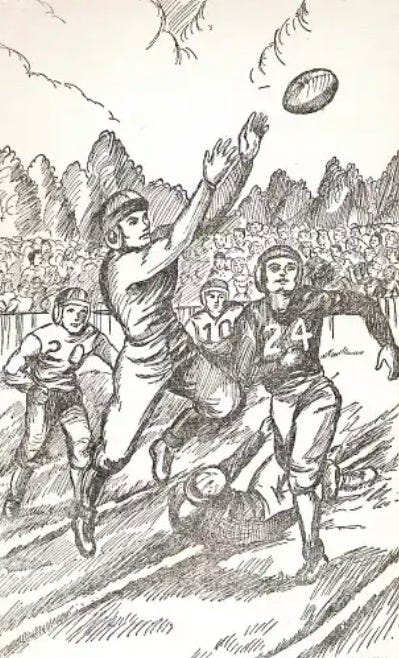Today's Tidbit... When Passing Into The End Zone Became Legal
We take for granted back-shoulder passes into the front corner and fade routes in the back corner of the end zone, yet both exist today due to a long line of changes to football's rules, strategies, and techniques. Neither was legal in football's early passing days, so let's look at why that was so and the changes that gave us such exciting plays.
When football adopted the forward pass in 1906, most did not expect the play to have much impact. Little did they know how innovative coaches and players would make that view seem quaint, but many of the passing game’s advances came only after football eased its many restrictions on tossing the pea. We discussed other restrictions on the forward pass here, so this Tidbit focuses on rules limiting the offense's ability to throw the ball past the goal line, each of which limited teams’ willingness to throw the ball in the red zone, if not further out.
The early football gods preferred that teams move the ball by rushing it on workmanlike drives or executing artful punts. They put rules in place to restrict long passes because they saw them as resulting from luck, not skill. Since no one had experience throwing long passes, they were largely right about the luck-skill issue initially, but that changed in time.
Throwing the ball over the opponent's goal line resulted in a touchback in 1906, so the only way to score a touchdown via a forward pass was to catch the ball in the field of play and carry it over the goal line. (During the 1910 season, passes more than 20 yards downfield were also illegal.)
With the introduction of end zones in 1912, players could catch the ball in the end zone, while incomplete passes in the end zone remained touchbacks. That rule remained in place until 1934 when things loosened up by allowing one incomplete pass in the end zone per series. (The second incomplete pass in the end zone was a touchback.) Four years later, the rule changed again, so only an incompletion on fourth down was a touchback. Much like the old rule for missed field goals, incomplete passes on fourth down thrown from the 5-, 45-, or other yard lines were treated equally - the ball came out to the 20-yard line.
Today, incomplete passes into the end zone do not have special meaning, but it is worth covering two additional perspectives related to throwing the ball into and catching the ball in the end zone. One concern involved crowd controls relevant today only in youth football or the remotest of remote high schools. A columnist for a Dayton newspaper argued in 1913 that unfenced football fields made the pass into the end zone rule difficult for officials to enforce properly:
... At big college games where the gridirons are so arranged that it is impossible for spectators to interfere with the players, passes across the line occasion no argument. But the majority of the gridirons in the country are located in open fields where the interference by the crowd hampers the officials a great deal. On fields like these it would be wise to play under rules that did not permit a forward pass to be made across the line. Then the officials could always tell whether the plays were legal or not.
'Might Quelch Pass Behind the Line,' Dayton Herald, December 20, 1913.
Of course, since the rules were made by those involved in big-time football, the Dayton argument had no impact; the little guys had to control their crowds for suffer the consequences.

A second issue involved clarifying the definition of a completed pass in the end zone. The rules lacked clarity until 1914, when they amended them to confirm:
... the position of the feet of any legal player receiving the ball and not the position of the ball itself, shall determine whether it is a properly completed forward pass within the end zone.
Rule XVII, Section 6, 1914 Spalding's Official Foot Ball Rules
Just as a player who stepped out of bounds before extending the ball across the goal line did not earn a touchdown, the rule confirmed the position of the player possessing the ball took precedence over the ball's location. That rule has stood the test of time, remaining in place nearly ninety years later.
Football Archaeology is reader-supported. Click here to buy one of my books or otherwise support the site.



Thanks for the comment and good points. Had the rules allowed passing into the end zone, I would agree with you, but the early restrictions were, um, restrictive. End zones did not not make the top 11 innovations I noted in How Football Became Football, but since we are coming close to the start of the NCAA basketball tournament, it might make my last four out. Still fun to discuss.
IMHO, the invention of the end zone was almost as important as the legalization of the forward pass. Before there was an end zone, on plays near the goal line the defense simply stacked the box, with no need to account for anyone except the eventual ballcarrier. It was hard for the offense to get the ball over the goal. The result was a lot of deadly, low-scoring games. (Of course, if you were an aficionado of tight defensive struggles, this was your era.) But once there was an end zone, the defense had to worry about receivers getting free and running behind them. The scores soon began to resemble those we are accustomed to today.